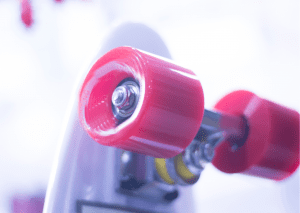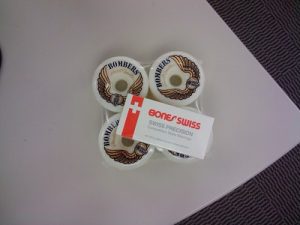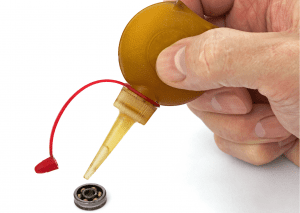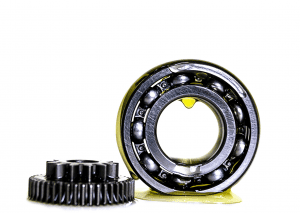We understand how frustrating it can be when the wheels of your board don’t roll quite right. That’s why we’re here to help with our do-it-yourself guide to lubricating skateboard bearings.

Bearings are a crucial part of performance, and proper maintenance is key for a smooth skate. Well-lubricated quality bearings are one edge of optimal performance. This article will help you spot signs of trouble before they take you off track and provide you with step-by-step instructions for cleaning your skateboard bearings as well as a guide to reassembling and testing your ride.
Together, we’re helping to ensure the perfect ride every time! Let’s make sure your board is rolling smoother than ever so you can keep shredding the pavement with confidence!
Key Takeaways
This article aims to know more about keeping your skateboard bearings clean. It isn’t just about quiet rides; it’s about the longevity of our boards. With the proper care and maintenance of skateboard components, you can ensure that your board will last for years to come. Here’s to smooth and effortless rides ahead!
Lubrication is important for your skateboard bearings, as it helps reduce friction, wear, and heat. In addition, it prevents corrosion, which can lead to failure of skateboard bearings. Without it, you might find yourself grinding to a halt mid-ride, which is like running a marathon with no water.

Importance Of Skateboard Bearings Lubricant
Different skateboard bearings have varied lifespans, but lubricating extends them all. Its main benefits are rust protection and reducing friction between moving parts. To save ourselves some trouble, let’s take a look at how we can identify signs of poorly lubricated bearings, especially when dealing with dirty bearings.
Bearings, which are made of metal components like rollers, cages, and retainers, are the moving parts that spin around the shaft, the cages are the structures that keep the rollers in place, and the retainers keep the rollers from bouncing out.
So, how can you tell if your skateboard bearings are properly oiled? Some signs to look out for include grinding noises and wobbling wheels. Additionally, you can check for a thin layer of oil or grease on the skateboard bearings. If it’s gone, that’s a sign that it needs to be re-lubricated or re-greased to prevent increased friction and ensure a smoother ride.
Identifying Signs Of Poorly Lubricated Bearings
If you’re a skateboarder, you’re aware that inadequate maintenance of your bearings can lead to significant problems, including wear and tear. Luckily, with the right knowledge and tools, you can often spot the signs of poorly lubricated bearings before it’s too late.

Here’s a quick guide to help you identify the signs of poorly lubricated bearings.
- Listen To Your Skateboard Parts And Bearings Carefully
Listen out for tell-tale grinding or squeaking noises that are hard to ignore. If your ride feels rougher than usual or your wheels slow down quickly due to friction, it could be a sign that your bearings are due for some oiling. You’ll also find that your board won’t last as long on the road, as a lack of oiling can shorten the lifespan of your bearings.
- Get Yourself A Skateboard Bearing Lubrication Tool Kit
Before you start to despair, we recommend gathering your toolkit and making sure your board is well-lubricated. With the right tools, you’ll be able to keep your skateboards in optimal condition.
Gathering Supplies
Gathered around your workbench, there’s a collection of supplies that’ll make this maintenance task a breeze. With careful tool selection and budget considerations, we can ensure our decks and wheels keep rolling smoothly.
You’ll need a skate tool, cleaning solution, lubricant, and some old rags. Remember, it’s not about buying the most expensive items but finding what works best for you. Now that we’ve got everything in place let’s dive into how to actually clean your bearings.
Cleaning
Everyone understands how important it is to keep your bearings running smoothly. Regular maintenance is the key to a safe and smooth ride, and by keeping up with the right cleaning solutions, you can avoid any build-up of gunk that would otherwise hinder performance.

This article wants to help you get the most out of your skateboards, so here’s a step-by-step guide on how to clean and lubricate your bearings for maximum efficiency.
Now, let’s move on to the actual cleaning process. Remember to use appropriate cleaning solutions.
Disassemble the bearings with care, making sure to remove bearings carefully, and wipe away any visible dirt or grime using a clean, lint-free cloth. Additionally, check for any remnants of old grease that may be present. For a more thorough cleaning, consider using isopropyl alcohol. While hydrogen peroxide can be effective in cleaning certain components, it may not be the best choice for cleaning skateboard bearings.
To clean the bearings, dip a Q-tip into the alcohol and carefully clean the smaller and harder-to-reach areas, including the inner race, metal shield, and all the balls. If your bearings have rubber shields, take care to clean both the inner and outer sides of the shields as well. It is not recommended to use a small pin for this process as it may risk damaging the delicate components of the bearings. Place the bearings in a container or tray, pour some alcohol over them, and swish the container, moving them back and forth to enhance cleaning. Spinning the bearings to ensure the alcohol reaches all parts can be an effective tip. You can expedite the drying process by using a hair dryer or simply allow them to air dry completely before reassembly.
Lubricating Skateboard Bearings
Now that the parts have been cleaned meticulously, it’s time to lubricate the bearings. Let us also know how the right oiling can make a big difference to the board’s performance.
Once the bearings are dry, apply a few drops of bearing lubricant or light oil to each bearing. Hold the bearing by the inner race and spin it to distribute the lubricant evenly. Avoid over-lubricating, as excess lubricant can attract dirt.
If you have ceramic bearings, it’s crucial to use lubricants specifically designed for ceramic bearings to maintain their performance. Not only does the right lubricant type promote speed, but it also helps to keep your ride safe and enjoyable. Longevity depends on the type of lubricant used, so it’s important to choose wisely.
Reassembling Your Skateboards
After a successful lubricating session, we’re ready to get our board back in top shape. We’ll guide you through the process of reinstalling your bearings and checking how smoothly your board now rides. Trust us, the satisfaction of feeling that improved glide under your feet is worth every minute spent on this do-it-yourself project!
Reinstalling The Bearings
Now that you’ve successfully oiled your bearings, it’s time to get them back in place. We know how important it is to properly maintain your board, and that includes reinstalling the bearings.
Once the lubricated bearings, including metal shields, inner metal ring, ball cage, and bearing race, are dry, align and press them into the wheel hubs. Secure the wheels onto the skateboard trucks, tightening the nuts. Check for smooth rotation, wipe off excess lubricant, and ensure proper seating for optimal performance.
Here are some tips for placement and overall maintenance:
- Be gentle when inserting the skateboard bearings into the wheel axles.
- Remember, each skateboard wheel needs two bearings.
- Double-check skateboard bearing and everything that is in place before you move on.
- Patience is key; don’t rush this process.
By following these steps, you can ensure the smoothness of your ride and that your ride remains in good condition. After all, skateboarding is a great way to have fun and stay active, so make sure to take care of your board.
Testing The Smoothness Of Your Ride
So, you’ve got your bearings back in place, and it’s finally time to test the smoothness of your ride. Let us seal this guide by making sure that we give our boards a good push and feel for any changes in ride comfort or speed control.
If you’re an avid rider, you know that the right setup can make all the difference when it comes to the smoothness of your ride. So, let’s check out the components of the skateboards: the deck, trucks, wheels, and bearings. Make sure the deck is suitable for your riding style, that the trucks and wheels are compatible, and that the parts are properly oiled.
If it feels off, don’t worry! It might take a few rides to break in those newly lubed bearings.
Are Motor Oil, Olive Oil, And Vegetable Oil Effective?
While motor oil, vegetable oil, and even cooking oil can offer some lubrication for the bearings of your board, they are not the best choices. A few differences exist between these general-purpose oils and specifically designed skateboard-bearing lubricants, which are recommended for optimal performance as they are designed to withstand the specific demands of skateboarding. They provide low friction, better protection against wear and contaminants, and contribute to less resistance, ensuring a smoother ride.
Conclusion
We’ve been there, folks. That unbearable screech from our beloved bearings can really grind our gears. Before you splurge on a new set, clean your bearings and keep them lubricated. You might encounter a little greasy finger, but cleaning bearings can go a long way. We’d love to hear your thoughts and feedback on our guide, so don’t forget to share your experience with us. Remember, cleaning and oiling your board’s parts isn’t just about quiet rides; it’s about the longevity of our boards.
Here’s to smooth and effortless rides ahead!
Frequently Asked Questions (FAQs):
Is It OK To Use Vegetable Oil As Lube?
Using vegetable oil as lube for the bearings of skateboards is not recommended. While it might work temporarily, vegetable oil can attract dirt and debris, leading to decreased performance and potential damage to the bearings in the long run.
Can I Use Vaseline On My Skateboard Bearings?
It is not recommended to use Vaseline on the board’s bearings. Vaseline is not designed as a bearing lubricant and may not offer sufficient lubricating properties for the metal surfaces inside the bearings. Instead, use a specific bearing lube designed for skateboard’s bearings to ensure proper maintenance and performance, or consider getting new bearings if your current ones are dirty or not functioning optimally.
Does 3 In 1 Oil Serve As A Suitable Lubricant For Bearings?
3-in-1 oil can work as a temporary solution for lubricating bearings, but it is not the best option for long-term use. Specific skateboard lubricants for bearings are designed to provide better performance and durability, protecting the bearings and ensuring smooth rides.
What Can I Use To Lubricate My Bearings?
You can use various lubricants to maintain your bearings, including specific lubricants for skateboards like Bones Speed Cream, Tri Flow, and Bronson Speed Lubricant. If you can’t get your hands on these mentioned lubricants, consider alternatives such as motor oil, bike grease, lithium grease, molybdenum grease, sewing machine oil, and even cooking oils like canola or olive oil. It’s important to note that while bearing shield cleaning can help maintain the ball bearings, it is not a lubricant. Therefore, using oil-based lubricants or marine grease would be more suitable for keeping the bearings of your skateboards in good working condition.
Is Cooking Oil Good For The Bearings Of My Board?
While cooking oil like canola or olive oil can serve as temporary bearing lube alternatives, especially for emergency situations, it is not the best choice for long-term use. Cooking oils can attract dust and debris, leading to faster bearing wear and potential performance issues with the board’s wheels. For optimal performance and durability, it’s recommended to use a specific bearing lube designed for skateboards.
Is It OK To Put WD-40 On Skateboard Bearings?
It is not recommended to put WD-40 on the bearings of skateboards. While WD-40 might offer some temporary support for the moving parts, it is not formulated for prolonged effectiveness and can attract dust and debris. This may result in heightened wear on the bearings and potential damage to the rubber seals and inner metal rings. For proper bearing maintenance of your board, it’s best to use a specific bearing lubricant for skateboards that is designed to protect and enhance the performance of the bearings without causing any damage to the rubber seals or inner metal rings.
Which Oil Is Best For Bearing?
The best oil for the bearings of skateboards is a specific bearing oil or lubricant designed for skateboarding. Using a proper bearing oil ensures optimal performance and longevity for the bearings while also protecting the bearing shields and rubber seals. Avoid using general oils like cooking oils or WD-40, as they may attract dust and debris, causing the bearings to become dirty and potentially leading to decreased performance and durability.
Is Rubbing Alcohol Good For The Bearings Of Skateboards?
Rubbing alcohol, such as isopropyl alcohol, can be effective for cleaning the skateboard bearings, especially when dealing with dirty bearings. It aids in the removal of dirt, grime, and old lubricant from the skateboard bearing shields and rubber seals. However, it is not suitable for lubricating the bearings. For lubricate properly, it is recommended to use a specific skateboard-bearing lubricant designed for optimal performance and longevity.
Can I Use Vinegar To Clean The Bearings?
Using vinegar to clean bearings is not recommended. While vinegar may help dissolve some grime and dirt, it is acidic and can potentially damage the bearing shields and other metal components. Instead, it’s best to use a suitable bearing cleaner like ionic flux, which is designed for cleaning the bearings of your board without causing any harm to the components. When using a cleaner, ensure it’s a non-corrosive solvent specifically formulated for bearings to maintain their optimal functionality and lifespan.
Can You Clean Bearings With Dish Soap?
Yes, you can clean bearings with dish soap. To do this, first, remove the skateboard bearing shields using a razor blade, then soak the skateboard bearings in a solution of dish soap and water. Use a paper towel to wipe away any dirt or grime, rinse the skateboard bearings thoroughly, and allow them to dry completely before reassembling the bearings.
Last Updated on June 7, 2024 by Allen Laconsay
DISCLAIMER (IMPORTANT): This information (including all text, images, audio, or other formats on FamilyHype.com) is not intended to be a substitute for informed professional advice, diagnosis, endorsement or treatment. You should not take any action or avoid taking action without consulting a qualified professional. Always seek the advice of your physician or other qualified health provider with any questions about medical conditions. Do not disregard professional medical advice or delay seeking advice or treatment because of something you have read here a FamilyHype.com.